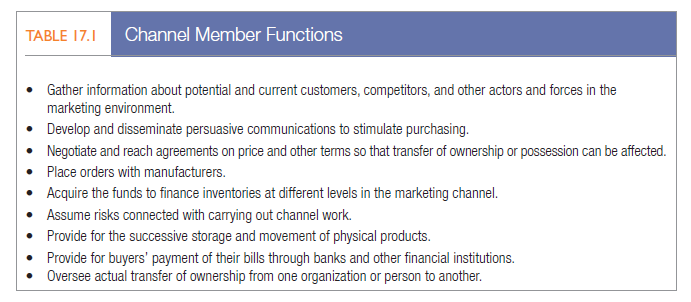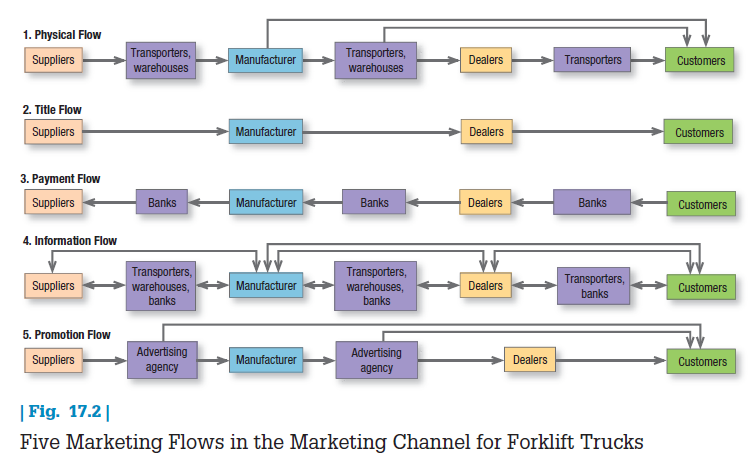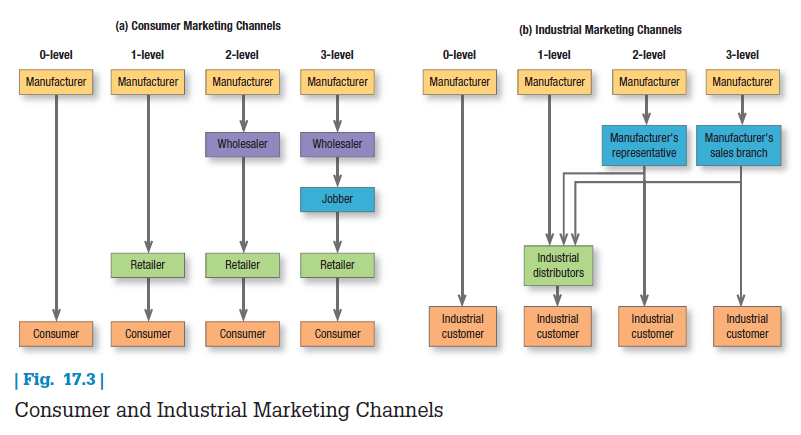Why does a producer delegate some of the selling job to intermediaries, relinquishing control over how and to whom its products are sold? Through their contacts, experience, specialization, and scale of operation, intermediaries make goods widely available and accessible to target markets, offering more effectiveness and efficiency than the selling firm could achieve on its own.25
Many manufacturers would find it cost prohibitive to open up their own stores—their best options are to tap into established dealer and retailer networks.

Many producers lack the financial resources and expertise to sell directly on their own. The William Wrigley Jr. Company would not find it practical to establish small retail gum shops throughout the world or to sell gum online or by mail order. It is easier to work through the extensive network of privately owned distribution organizations. Even Ford would be hard-pressed to replace all the tasks done by its almost 8,500 dealer outlets worldwide.26
1. CHANNEL FUNCTIONS AND FLOWS
A marketing channel performs the work of moving goods from producers to consumers. It overcomes the time, place, and possession gaps that separate goods and services from those who need or want them. Members of the marketing channel perform a number of key functions (see Table 17.1).
Some of these functions (storage and movement, title, and communications) constitute a forward flow of activity from the company to the customer; others (ordering and payment) constitute a backward flow from customers to the company. Still others (information, negotiation, finance, and risk taking) occur in both directions. Five flows are illustrated in Figure 17.2 for the marketing of forklift trucks. If these flows were superimposed in one diagram, we would see the tremendous complexity of even simple marketing channels.

A manufacturer selling a physical product and services might require three channels: a sales channel, a delivery channel, and a service channel. To sell its Bowflex fitness equipment, the Nautilus Group historically has emphasized direct marketing via television infomercials and ads, inbound/outbound call centers, response mailings, and the Internet as sales channels; UPS ground service as the delivery channel; and local repair people as the service channel. Reflecting shifting consumer buying habits, Nautilus now also sells Bowflex through regional and national retailers such as Sears and Dick’s Sporting Goods as well as through online merchants such as Amazon.com.
The question for marketers is not whether various channel functions need to be performed—they must be— but, rather, who is to perform them. All channel functions have three characteristics in common: They use up scarce resources; they can often be performed better through specialization; and they can be shifted among channel members. Shifting some functions to intermediaries lowers the producer’s costs and prices, but the intermediary must add a charge to cover its work. If the intermediaries are more efficient than the manufacturer, prices to consumers should be lower. If consumers perform some functions themselves, they should enjoy even lower prices. Changes in channel institutions thus largely reflect the discovery of more efficient ways to combine or separate the economic functions that provide assortments of goods to target customers.
2. CHANNEL LEVELS
The producer and the final customer are part of every channel. We will use the number of intermediary levels to designate the length of a channel. Figure 17.3(a) illustrates several consumer-goods marketing channels of different lengths.
A zero-level channel, also called a direct marketing channel, consists of a manufacturer selling directly to the final customer. The major examples are mail order, online selling, TV selling, telemarketing, door-to-door sales, home parties, and manufacturer-owned stores. Traditionally, Franklin Mint sold collectibles through mail order; Red Envelope sold gifts online; Time-Life sold music and video collections through TV commercials or longer “infomercials”; nonprofits and political organizations and candidates use the telephone to raise funds; Avon sales representatives sold cosmetics door to door; Tupperware sold its containers via in-home parties; and Apple sold computers and other consumer electronics through its own stores. Many of these firms now sell directly to customers online and via catalogs. Even traditional consumer-product firms are considering adding direct-to-consumer e-commerce sites to their channel mix. Kimberly-Clark launched an online Kleenex Shop in the United Kingdom.27
A one-level channel contains one selling intermediary, such as a retailer. A two-level channel contains two intermediaries, typically a wholesaler and a retailer, and a three-level channel contains three. In the meatpacking industry, wholesalers sell to jobbers, essentially small-scale wholesalers, who sell to small retailers. In Japan, food distribution may include as many as six levels. Obtaining information about end users and exercising control become more difficult for the producer as the number of channel levels increases.

Figure 17.3(b) shows channels commonly used in B-to-B marketing. An industrial-goods manufacturer can use its sales force to sell directly to industrial customers, or it can sell to industrial distributors who sell to industrial customers, or it can sell through manufacturer’s representatives or its own sales branches directly to industrial customers or indirectly to industrial customers through industrial distributors. Zero-, one-, and two-level marketing channels are quite common.
Channels normally describe a forward movement of products from source to user, but reverse-flow channels are also important (1) to reuse products or containers (such as refillable chemical-carrying drums), (2) to refurbish products for resale (such as circuit boards or computers), (3) to recycle products, and (4) to dispose of products and packaging. Reverse-flow intermediaries include manufacturers’ redemption centers, community groups, trash-collection specialists, recycling centers, trash-recycling brokers, and central processing warehousing.
3. SERVICE SECTOR CHANNELS
Many of the most successful new banks, insurance and travel companies, and stock brokerages have emerged with strictly or largely online operations, such as Ally banking, Esurance insurance, Expedia travel, and E*TRADE investments. Marketing channels also keep changing for “person marketing.” Besides providing live and programmed entertainment, entertainers, musicians, and other artists can reach prospective and existing fans online in many ways—through their own Web sites, on social community sites such as Facebook and Twitter, and through third-party Web sites. Politicians also must choose a mix of channels—mass media, rallies, coffee hours, spot TV ads, direct mail, billboards, faxes, e-mail, blogs, podcasts, Web sites, and social networking sites— for delivering their messages to voters.
Nonprofit service organizations such as schools develop education-dissemination systems and hospitals develop health-delivery systems. These institutions must figure out agencies and locations for reaching a far-flung population.28
CLEVELAND CLINIC One of the largest and most highly respected hospitals in the country, Cleveland Clinic provides medical care in a variety of ways and settings. Its main campus in Cleveland, 50 buildings on 166 acres, is its hub for patient care, research, and education. The clinic also operates 16 full-service Family Health Centers in the suburbs, while eight hospitals extend its reach in Northeast Ohio. Community outreach programs in all these areas provide patient education and free health screenings. Cleveland Clinic also offers major medical care in Florida, Toronto, and manages a Mubadala Development Company medical campus in Abu Dhabi, United Arab Eimireates, scheduled to begin seeing patients in 2015. It has a suite of secure online health services for both patients and physicians and is developing partnerships with Google and Microsoft to extend its online capabilities.
Source: Kotler Philip T., Keller Kevin Lane (2015), Marketing Management, Pearson; 15th Edition.

You should take part in a contest for one of the best blogs on the web. I will recommend this site!